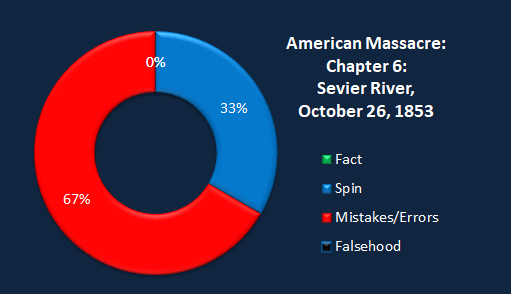
FAIR is a non-profit organization dedicated to providing well-documented answers to criticisms of the doctrine, practice, and history of The Church of Jesus Christ of Latter-day Saints.
| Chapter 5 | A FAIR Analysis of: American Massacre: The Tragedy at Mountain Meadows, a work by author: Sally Denton
|
Chapter 7 |

Jump to details:
The author claims that Brigham's fortification of villages against attack by the Indians was a reversal of Book of Mormon prophecies regarding the Lamanites.
Author's sources:
- No source provided, although the author dates this to July 21, 1853.
The author claims that Latter-day Saint elders were "in the habit of confiscating at will younger wives of less ranking members of the church."
Author's sources:
- No source provided.
In the Gunnison death, the Mormons are claimed to have defamed the victims while blaming the Indians.
Author's sources:
- No source provided.
Critics of Mormonism credit the story of Judge William W. Drummond of the Mormons' complicity in the death of Judge Leonidas Shaver, John Gunnison, and Almon Babbitt. However, two of these individuals were killed by Indians; the other died of natural causes and was not killed at all. The author ignores the biases of his source.
Noted one reviewer:
[Will] Bagley tries to support his fictional tale of a violent society by crediting the report of Judge William W. Drummond on murders committed by the Mormons. In a report that Norman Furniss and other authorities believe probably tipped the balance in favor of sending the army to Utah, Drummond charged that the Mormons engineered the murders of territorial delegate Almon Babbitt, Capt. John Gunnison, and Judge Leonidas Shaver. In spite of its flaws and prejudice, Bagley cites Drummond's report approvingly (77). In fact, Cheyennes killed Babbitt on the high plains, Gunnison died at the hands of Pahvant Utes, and Shaver died a natural death. [1]

FAIR is a non-profit organization dedicated to providing well-documented answers to criticisms of the doctrine, practice, and history of The Church of Jesus Christ of Latter-day Saints.
We are a volunteer organization. We invite you to give back.
Donate Now